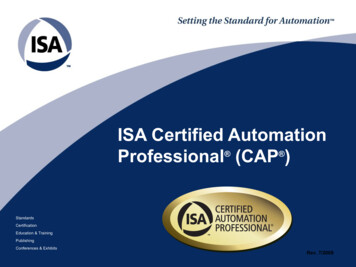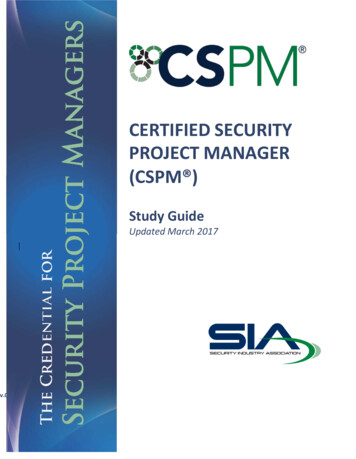
Transcription
v.060915CERTIFIED SECURITYPROJECT MANAGER(CSPM )Study GuideUpdated March 2017
CSPM Study GuideSection 1: How the Certification Examination is Developed . 1Job Task Analysis . 1Examination Specifications . 1Item Development .1Cut Score Study . 1Section 2: CSPM Examination Specifications . 2Section 3: Preparing for the Exam . 9Exam Content. 9Suggested References. 9Section 4: Sample Test Items . 10Contact: KRoberts@securityindustry.org
Section 1 – How the Certification Examination is DevelopedJob Task AnalysisA job task analysis defines the current knowledge, skills and abilities that are required forcompetent practice in the role of a security project manager. These competencies are defined byexperts in the security industry and are validated through surveys and focus groups. A largenumber of security project managers rate each knowledge element and skill for frequency andimportance as they relate to their professional role.Examination SpecificationsThe design of the examination is governed by the CSPM Examination Specifications (Section 2).This document defines the content domains (major areas of focus) and sub-domains (job tasks)covered on the examination and the percent of items (questions) covering each of these.Item DevelopmentThe CSPM Certification Committee is responsible for the development of the exam. The committeeis comprised of subject matter experts from different sectors of the security industry. Each memberformulates a number of questions (items) which are then reviewed by multiple members of thecommittee for consensus on the suitability of the content, construction of the question, andvalidation of the correct answer.Each item is referenced to a published reference. The list of references used to validate exam itemsis included in Section 3.Cut Score StudyThe CSPM Certification Committee must conduct a standard setting workshop to establish the cut(passing) score for the exam using subject matter experts who are knowledgeable and skilled in thefield. Participants are asked to have in mind 100 eligible candidates and determine the number ofthose they would expect to answer each question correctly. Easier items have higher ratings, andthe more difficult items, lower. A majority of easy items would result in a higher cut score. Studyparticipants are asked to read each exam question. Reviewers are then asked, “How many of the100 candidates would answer this item correctly?” Each of the items on the exam form is rated inthis manner. The ratings are tabulated and an average cut score is calculated. Individuals who meetor exceed the cut score pass and those that do not are not granted the credential.
Section 2: CSPM Examination Specifications1. Security Industry-Specific Knowledge & Initiation1.1.Security Project Fundamental Knowledge1.1.1.Access industry information sources for basic data and trends.1.1.2 Demonstrate knowledge of power requirements to the extent of identifyingwhen troubleshooting is required.1.1.3 Know the terminology, components of and how security products integratewith IT/IP systems.1.1.4Know the components, products and technologies of an access control system.1.1.5Know the components, products and technologies of biometrics.1.1.6Know the components, products and technologies of video technology.1.1.7Know the components, products and technologies of monitoring services.1.1.8Have core knowledge of monitoring services.1.1.9 Know requirements/specifications of products and technologies of electricalcomponents.1.1.10 Have knowledge of general construction codes, specifications divisions, andregulations.1.1.11 Have general knowledge of electronic surveillance solutions, RFID and similartechnologies.1.1.12 Know the components, products and technologies of fire detection andprotection.1.1.13 Know the components, products and technologies of data/cyber security.1.1.14 Know the components, products and technologies of physical securitystructures/devices.1.1.15 Have core knowledge of structural devices.1.1.16 Know the impact of lighting on the security design.27.5%10%
1.1.17 Know the components of voice communications relevant to security design.1.1.18 General awareness of integration of security management and other buildingand management systems.1.1.19 Know the components, products and technologies of intrusion detection.1.1.20 Have general knowledge of how security accessories fit into security designs.1.1.21 Have general knowledge of components of command and control centers andhow they are integrated.1.1.22 Have core knowledge and awareness of mass notification.1.2Understanding a Security Project’s Component Relationships1.2.1 Identify and explain company product’s features and solutions “featuredifferential” vis-a-vis other potential solutions.1.2.2 Identify and understand interoperability within an access control system andwith other systems in a security solution.1.2.3 Define interoperability within biometrics and with other systems in a securitysolution.1.2.4 Define interoperability within video technology with other systems in a securitysolution.1.2.5 Define interoperability within monitoring services with other systems in asecurity solution.1.2.6 Define requirements/specifications and interoperability with electricalcomponents and other systems in a security solution.1.2.7 Define interoperability within a fire detection and protection system with othersystems in a security solution.1.2.8 Define interoperability within data/cyber security and with other systems in asecurity solution.1.2.9 Define interoperability within physical security structures/devices and withother systems in a security solution.1.2.10 Define interoperability within intrusion detection and other systems in asecurity solution.10%
1.3Application of Basic Security Project Management Skills1.3.1Coordinate project activities with the IT Department.1.3.2Understand all codes and standards applicable to security projects.1.3.3Adhere to basic contract, construction and mechanics (lien) laws.1.3.4Participate in proposal design.1.3.5Review bids and proposals prior to submission.1.3.6Review proposals prior to contract signing.1.3.7Approve/authorize project and budget.1.3.8Review customer needs, scope of work, and sales documents.1.3.9Evaluate project specifications and proposed security solution.7.5%1.3.10 Assess project risks and analyze effects.1.3.11 Assess project design, specification, materials, and requirements.1.3.12 Develop mitigation/contingency plan for identified risks.1.3.13 Document the initial requirements to meet the customer’s needs andexpectations.1.3.14 Identify the resources and support needed for the project.1.3.15 Complete and submit internal pre-project documents, contracts, andagreements.1.3.16 Complete and submit external pre-project documents or legal agreements.1.3.17 Conduct transition meeting between sales team and implementation team.1.3.18 Conduct transition meeting between sales team and customer contact.1.3.19 Conduct on-site customer meeting and project survey.1.3.20 Conduct subcontractors meeting to review project specifications.2. Planning2.122.5%Team2.1.1 Create a project management plan, including the Identification of roles,responsibilities, needed skill sets, and reporting relationships for the project team.2.1.2 Assemble the internal and external project team necessary to complete the project.7.5%
2.1.3Establish team goals and negotiate and define team member roles.2.1.4Identify the training needs for the project.2.2Processes7.5%2.2.1 Analyze project activity sequences and durations, potential constraints anddevelop a project schedule.2.2.2Develop and finalize a budget.2.2.3 Approve quality standards for the project and procedures for assuringstandards are met.2.2.4Develop a communication plan for the project.2.2.5Develop project purchasing and billing plan.2.2.6Circulate project schedule for agreement and approval.2.2.7 Understand and perform the necessary legal review process for securityprojects.2.2.8Review and communicate safety protocols for project activities.2.2.9 Evaluate project deliverables and divide them into activity components (workbreakdown structure).2.1.Materials7.5%2.3.1 Determine the type and quantity of materials, equipment, and supplies neededfor the project.2.3.2Identify suppliers of needed materials and equipment.2.3.3Specify needed computer and network equipment for project team.3. Execution22.5%3.1People3.1.1Deploy the project team.3.1.2Manage team member performance and provide feedback.3.1.3Manage a process for identifying and solving problems and their resolutions.3.1.4Manage subcontractor relationships and schedule their activities.7.5%
3.1.5Identify potential issues and present concerns to management.3.1.6Maintain internal communications.3.2Software3.2.1Employ and execute the project tracking software.3.2.2Implement budget tracking software.3.2.3Implement communication and presentation software.3.3Documentation & Change3.3.1Keep record of all project activities in progress and completed.3.3.2Keep record of project specifications and all changes.3.3.3Maintain records of approved and implemented change orders for finalsubmissions and drawings of project.3.3.4Assemble project file with project specifications and records.3.3.5Maintain accurate updated red-line drawings.3.3.6Document the acquisition and distribution of project materials, equipment, andsupplies.3.4Control & Procurement3.4.1Implement a process for change orders.3.4.2Execute earned value calculations and reports.3.4.3Identify areas to consolidate activities and cut costs with the project.3.4.4Obtain and review the approved submittals and shop drawings for the project.3.4.5Procure needed materials and services.3.4.6Organize and manage material and equipment procurement schedules.4%6%5%4. Monitoring15%4.1Documentation & Change4.1.1Document and approve changes to the scope of work or project timeline.4.1.2Determine and submit budget and schedule implications for change orders oradjustments.6%
4.1.3Ensure safety protocols, codes and regulations are followed and documented.4.2Communications4.2.1Write and distribute project update reports for project team.4.2.2Write and distribute project update reports for stakeholders.4.2.3Track and reconcile project team activities and time with project specifications.4.2.4Assure quality of project activities and identify areas for improvement.4.3Project Tracking4.3.1Monitor project status and budget.4.3.2Monitor project activities on-site.4.3.3Monitor organizations or individuals that have been subcontracted for aproject.4.3.4Approve and accept completed project activities by staff and subcontractors.4.3.5Manage project payables and receivables.4.3.6Monitor and track actual vs. anticipated expenses.5. Project Closing66%3%7.5%5.1.1Complete and distribute project specific documents and paperwork.5.1.2Review and approve all final invoices for payment.5.1.3Approve project and certify that all requirements were met.5.1.4Compile, complete and submit final contract documents to end-user or owner.5.1.5Obtain sign-off / approval by end-user or owner.Management Skills6.1.1Utilize standard management methodologies for performance evaluation,coaching, performance improvement and career development as applicable.6.1.2Understand key measures of project management and determine, analyze andinterpret them.6.1.3Adhere to SIA Code of Ethics in all situations.5%
6.1.4Communicate effectively orally and in writing.6.1.5Appropriately manage individual and team conflict.6.1.6Conduct productive meetings.6.1.7Indicate, direct and train as necessary.
Section 3 – Preparing for the ExamSIA does not endorse any specific person, product, resource, or service as a means ofpreparing for or achieving certification. Candidates are encouraged to plan their owncourse of study by reviewing the CSPM Examination Specifications, identifying any areasof weakness, and securing the necessary resources to adequately prepare for theexamination.Exam ContentThe examination is comprised of 125 items and must be completed in two hours.To become familiar with the content areas on the examination, candidates should refer tothe CSPM Examination Specifications (Section 2). Candidates are encouraged to reviewthis document to assess their level of knowledge in each of the content areas, and toidentify the areas in which they believe they need additional preparation.Suggested ReferencesThe following list of primary references are those used by the CSPM CertificationCommittee to validate the content of the examination. The secondary references mayprove valuable to candidates looking to enhance their knowledge in particular topic areas.Primary Suggested Reference Sources A Guide to the PMBOK , Fifth Edition, Chapters 6.1, 7.2.2, 8.1.3, 9.1.3, 9.2.1, 9.3, 9.3.2Security Project Management Common Body of Knowledge Guidebook, 1st Edition,Security Industry AssociationImplementing Physical Protection Systems: A Practical Guide, 2nd Edition, David G.Patterson IIIConstruction Contract Administration Practice Guide, Construction SpecificationsInstituteInternational Building Code 2012, International Code CounselNFPA 80: Standard For Fire Doors And Other Opening Protectives, National FireProtection Association, 2013.Additional Suggested Reference Sources G704 Certificates of Substantial Completion, American Institute of Architects (AIA)Audiovisual Best Practices: The Design and Integration Process for the AV andConstruction Industries, Timothy W. Cape and Jim Smith (Jun 1, 2005)Business Security Handbook, Jerry Antoon, CPP, RLEffective Physical Security, 4th Edition, Fennelly, Lawrence
Introduction to PoE and the IEEE802.3af and 802.3at Standards, Eisen, Morty. 2009MasterFormat Numbers & Titles, The Construction Specifications InstituteNational Electrical Code 2005, National Fire Protection Associations National ElectricalCode (Sep 22, 2004)ONVIF Overview, Open Network Video Interface ForumUnderstanding Security Basics: A Tutorial on Security Concepts and Technology,Kibbey, Richard. 2005Structural Bases of Interpersonal Influence in Groups: A Longitudinal Case Study,Friedkin, Noah. 1993The Design and Evaluation of Physical Protection Systems, 2nd Edition, Garcia, MaryLynnSection 4: Sample Test ItemsThe following sample questions are intended to provide samples of the types of itemformats and editorial characteristics that candidates can expect to encounter on theexamination.These items are not intended as a self-assessment instrument nor should they be used topredict success or failure on the CSPM exam.1. A Project Manager’s main responsibility is to:A. maintain overall security of the project site.B. meet with the owner and review his/her changing needs.C. review, document and approve changes to scope and timeline.D. ensure vendors and contractors perform work to agreed scope.2. When it is necessary to obtain a clarification or interpretation of a code or standard ona particular project, the Project Manager should ALWAYS communicate with the:A. authority having jurisdiction.B. client representative.C. International Codes Council representative.D. the local Municipal Code Office.3. What is required to implement Anti-Passback in an access control system?A. A closed area with one entry pointB. Turnstiles allowing only a single person to enterC. Access locations with readers at every entry/exit pointD. Barriers not allowing cards to be passed back
4. Alarms are only effective if there is a:A. monitoring station.B. response.C. guard force.D. video surveillance system.5. Which type of access credential card operates bi-directionally on anembedded processor?A. Weigand cardB. Smart cardC. Barium ferrite cardD. Proximity card6. On-time performance, failure rates and reliability measurements are all metrics usedin:A. developing cost estimates and work breakdown schedules.B. determining earned value and budgeted costs of work performed.C. performing quality assurance and quality control processes.D. calculating sub-contractor’s bonuses and incentive payments.7. Which of the following is NOT a critical aspect of the kickoff meeting?A. Cost analysisB. ScheduleC. TimelineD. Meetings8. Ways in which project managers can facilitate teamwork include all of thefollowing, EXCEPT:A. providing timely feedback and support.B. using open and consistent communication.C. delegating as much responsibility as possible.D. managing conflict in a constructive way.
9. The project manager fails to catch a relatively small error in a vendor’s costestimate, and then finds the error later in the project. What is the appropriateresponse?A. Deduct it from the vendor’s final paymentB. Explain the error to the client and request a budget adjustmentC. Independently cover the shortfall from another area of the budgetD. Submit the error with other change orders10. How would a Project Manager determine when to schedule the installation of electriclocks for a new construction project?A. Review the door hardware scheduleB. Consult the General Contractor’s scheduleC. Review the door delivery scheduleD. Consult the Statement of Work document11. Based on the drawing below, which is the most cost-effective lens to use forcapturing video of persons entering the target area?A. 2.5 mm fixedB. 12 mm fixedC. 2.5 – 12 mm zoomD. 5 – 8 mm zoom12. The Scope of work requires the use of biometrics for verification at a card reader door.What statement would be the MOST correct?A. Biometric data must be stored on a smartcardB. Biometric data must associate with card dataC. Biometric data must be stored in the readerD. Biometric data is separate from the card data
13. You can minimize confusion and lost progress on a project by:A.B.C.D.having a meeting to discuss problems on the project.properly documenting any changes to the scope of work.requiring that all stakeholders attend each meeting.ensuring the architect is aware of any and all changes.Answer Key1:C, 2: A, 3: C, 4: B, 5: B, 6: C, 7: A, 8: C, 9: B, 10: B, 11: B, 12: B, 13: B
1.2.8 Define interoperability within data/cyber security and with other systems in a security solution. 1.2.9 Define interoperability within physical security structures/devices and with other systems in a security solution. 1.2.10 Define interoperability within intrusion detection and other systems in a security solution.
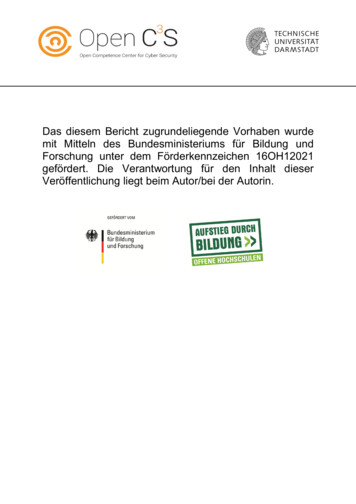
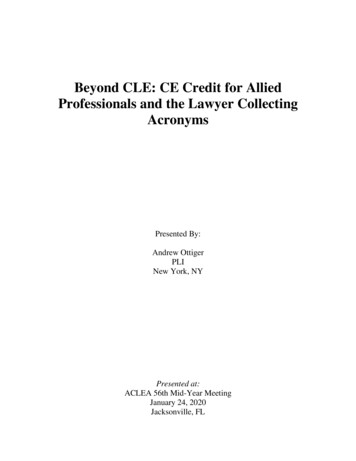
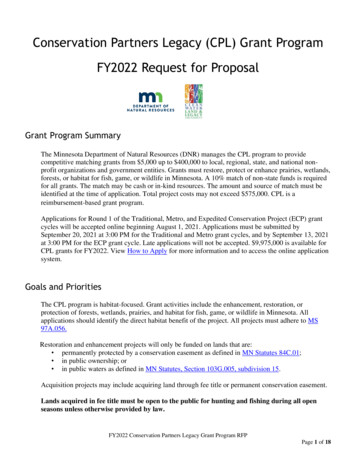
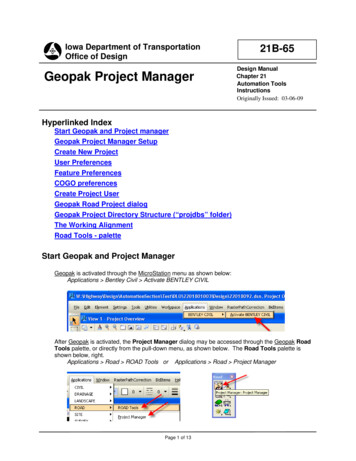
![[ CERTIFIED IN STERILE PROCESSING MANAGEMENT - CSPM ] Total Sat for .](/img/45/nov-2019-cbspd-certs.jpg)
![[ CERTIFIED IN STERILE PROCESSING MANAGEMENT - CSPM ] Total Sat . - CBSPD](/img/45/feb-2019-cbspd-certs.jpg)


